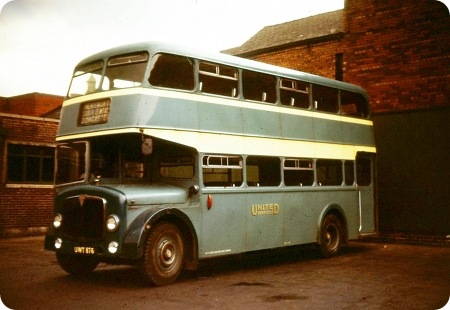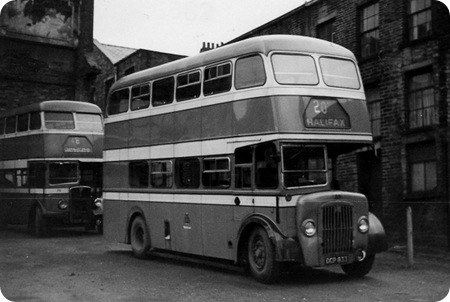
United Services
1957
AEC Regent V
Roe L27/26RD
W. Everett & Son United Services to give them there full name operated from the Yorkshire village of Kinsley which is between Barnsley and Pontefract they ran services to nearby towns such as Leeds, Wakefield, Barnsley and Doncaster.
This bus delivered new to United Services along with UWT 875 another Regent V had a lowbridge body. If you look at first side window on the top deck you will see it has been smashed not by a bridge though looking at the bodywork.
United Services had quite a collection of second hand vehicles including a Dennis Loline from Aldershot & District and a very flash looking Titan with a Preston registration so ex Ribble, Scout or Standerwick I would guess.
A good place to see more United Services photos is on the United Services section of Huddersfield Passenger Transport Group website to view click here.
This particular United Services was in fact made up of three autonomous family businesses who operated stage carriage services from the late 1920’s/early 1930’s under the United Services brand but also ran their own coach and paddy bus operations.
Willie Everett, the founder of W Everett & Son was my Granddad and my uncle Harry is the ‘son’ in the company name. Their bus depot was in South Kirkby near the parish church. The Kinsley depot belonged to Bingley Brothers, one of the other United Service operators (who had bought the business from another family called Granters who had been the first bus operator in the area). Cooper Brothers was the third family business partly operating under the United Services brand and it had a depot at one end of Stockingate in South Kirkby. The bus pictured is almost certainly from the Bingley’s fleet.
John Wrightson
06/10/12 – 18:52
I’m no expert on buses, but I used to travel on the United Services regularly in the fifties. We lived in Morley and my grandma (maternal) lived in Hemsworth, so my mother paid a monthly visit carting me along with her! This involved catching the West Riding 57/58 to Wakefield and then the United Services to Hemsworth. In the days before Wakefield Bus station we’d get off the 57/58 in Wood Street and catch the United at the Springs bus stops. In those days many of the United buses were former coaches and had windows you could wind down, like a car – guess who made a nuisance of himself winding the windows up and down.
When the bus station was built it was just a matter of changing platforms.
If for some reason we missed the United, we’d catch the West Riding service from Leeds to Hemsworth – but this only went as far as Cross Hills and we had to walk the rest. I recall also another independent operator in Hemsworth – Ideal Motor Services – I wonder what happened to them.
Geoff Bragg
10/10/12 – 09:10
The ‘Ideal’ referred to would almost certainly be, coincidentally, another ‘co-operative’ (they weren’t all that common) – i.e. that of Taylor of Cudworth, and Wray of Hoyle Mill, Barnsley, both trading as ‘Ideal’ and sharing a service running between Barnsley and Pontefract. There is a section on Ideal on this very site.
Taylor’s ultimately sold out to Yorkshire Traction, but most of their vehicles passed to Wray’s, who, I think, finished up with more ex-Taylor vehicles than ex-Wray, so to speak. Wray’s continued for a few more years (presumably running in co-ordination with Yorkshire Traction) before themselves selling out to YTC.
Another service running between Barnsley and Pontefract (but by a slightly different route) was operated by South Yorkshire Motors, but I don’t know whether or not it ran via Hemsworth.
David Call
David I can help you there, as I worked for South Yorkshire and successors (several) from 1987 until I retired in 2001. Under the WYPTE excellent route numbering scheme the SYRT (joint with Yorkshire Traction) route from Pontefract to Barnsley became 245. The service was basically hourly between Pontefract and Barnsley, with "short workings" to Hemsworth (Highfield Estate) also every hour, making a half hour frequency between Pontefract and Hemsworth – the latter Monday to Saturday daytimes only. The route was via Featherstone, High Ackworth, Fitzwilliam, Kinsley, Hemsworth, Shafton, Cudworth and Lundwood to Barnsley. The SYRT share of the mileage was handed over to Yorkshire Traction, along with the three new SYRT Dennis Darts, late in 1994 after Caldaire Group (West Riding) took over Pontefract depot. There, I bet you wish you’d never asked !!
Chris Youhill
11/10/12 – 07:19
Not at all, Chris, I’ve read a great many of your posts and they’re all enjoyable.
One thing I certainly didn’t know was that the Pontefract to Barnsley service was joint SYRT/YTC. Having had a look at the current 245 timetable, and assuming that the Hemsworth shorts interworked with the through service, I would say that four buses were required to run the basic Monday to Saturday service – two SYRT and two YTC? What would have been the Hemsworth shorts look as though they now run through to Barnsley as service 244, and the ex-Ideal service is still recognisable as the 246.
David Call
11/10/12 – 09:05
Thank you David and, yes, you’re right in thinking on "interworking" lines – at least throughout daytime hours Monday to Saturday – and that four vehicles would be needed. The South Yorkshire vehicles (and presumably YT as well) did alternate trips from Pontefract to Barnsley and to Hemsworth Highfields, taking a little under four hours for each cycle. One particularly vicious journey with which we were faced (weekdays) was at 1810 from Pontefract to Barnsley which also diverted via Highfields, a narrow and tortuous estate where by that time of day there was flagrant double parking everywhere. I may be mistaken – its a long time ago now – but I’m pretty sure that South Yorkshire did all the Barnsley journeys on Sundays with two vehicles to balance the mileage agreement, and of course there were no "Highfields" on the Sabbath.
I do still visit friends in Pontefract and I think that the whole service network in the region has been considerably modified now, especially since Stagecoach took "Tracky", and the services running into Pontefract are numbered in the two digit "30s"
Chris Youhill
12/10/12 – 08:23
Indeed. When I checked back it seems that the timetable I had found was dated October 2006 – but still coming up on the internet, of course. What was the 245 has now become the 35, while the ex-Ideal service seems to have blossomed into the 46 and 47. I’m not saying the routes are exactly as they used to be, as you say services have generally been modified.
David Call
12/10/12 – 12:52
Both of the AEC’s, UWT 875/876 were delivered new to Bingleys in April, 1957. Out of curiosity, I looked at Bus Lists because T. Burrows of Wombwell had an identical vehicle, PWY 943. I’ve often wondered if they were ordered together but apparently not. The Burrows machine was delivered a year or so earlier and is listed as an MD3RV with the 7.7ltr. engine, the two Bingleys vehicles were D3RV’s with 9.6ltr. engines. The Roe bodies were identical though.
Chris Barker
13/04/13 – 07:23
Just a slight correction to the original text. The front window isn’t actually smashed – its the reflection of the gable end of the adjoining building – Bingleys only ever turned out pristine vehicles in service. Also they did not operate to Leeds and Barnsley as stated here. South Yorkshire Motors of Pontefract did and the confusion is because they also had a blue and white livery like United Services.
Mark B
31/05/14 – 08:01
Mention of the Ideal service, Barnsley – Pontefract, reminds me of the long service 70, operated jointly by Sheffield JOC and Yorkshire Traction, which ran from Sheffield to Upton. I often wondered why this stopped at Upton and didn’t run through to Pontefract. This would have required a fifth bus and a third operator.
The licensing system often made what seemed to be logical routes difficult.
Geoff Kerr
12/08/17 – 07:45
The "United" bus service was operated by a number of Companies in the area as stated. As I recall from growing up in the 50s Bingleys of Kinsley was known as W.R & P Bingleys. From memory I seem to remember that their buses were a darker blue than the one pictured. My Dad (Fred Stacey) did drive for them from time to time on a casual basis. As well as the Coaches used on "Trips" to the coast he would drive the "Mill Buses" which collected the Girls from the Mills and he often drove the Wakefield to Doncaster route along with Frank Bingley. They shared the duties for this using a Daimler Bus which I recall did something like 2 million miles in it’s lifetime. It was always the last bus out of Wakefield Bus Station at the weekend en-route back to Kinsley and if you missed it you walked.
Frank lived at the Upton Depot and operated from there. Albert Holmes was the Chief mechanic operating out of Gorton Street Depot in Kinsley and his Son (Paul) and I spent many happy hours playing in the garage known as Hunters Farm Garage. I also vaguely remember the Taxi they had which I believe was a Armstrong Siddeley.
These were happy times when life was at a different pace but I would bet journey times were no longer then than now.
David Stacey
30/08/22 – 07:02
I was looking for pictures of United Daimler/Duple (I think) GWW 49 and GWW 50 which I sometimes caught from Cross Hills to Wakefield for school (1949-1957). (Having come on an ‘Ideal’ to Hemsworth from Brierley). United had an elderly ‘high bridge’ double decker, ex-Leeds, I think. Great fun going round bends on the upper deck. One time, early 1950s (?) there was a strike, which didn’t involve ‘United’ crews, but we were made to get off on the outskirts of Wakefield.
John Lovett



